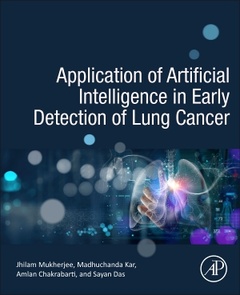Application of Artificial Intelligence in Early Detection of Lung Cancer
Auteurs : Chakrabarti Amlan, Kar Madhuchanda, Mukherjee Jhilam, Das Sayan

Application of Artificial Intelligence in Early Detection of Lung Cancer presents the most up-to-date computer-aided diagnosis techniques used to effectively predict and diagnose lung cancer. The presence of pulmonary nodules on lung parenchyma is often considered an early sign of lung cancer, thus using machine and deep learning technologies to identify them is key to improve patients? outcome and decrease the lethal rate of such disease. The book discusses topics such as basics of lung cancer imaging, pattern recognition techniques, deep learning, and nodule detection and localization. In addition, the book discusses risk prediction based on radiological analysis and 3D modeling. This is a valuable resource for cancer researchers, oncologists, graduate students, radiologists, and members of biomedical field who are interested in the potential of AI technologies in the diagnosis of lung cancer.
2. Basics of Lung Cancer Imaging
3. Terminologies of Lung cancer (biopsy, cytology, lung anatomy, radiological features related to lung cancer)
4. Overview of Pattern Recognition Technique
5. Deep learning Techniques
6. Nodule Detection (Segmentation of pulmonary abnormalities and differentiation of pulmonary nodule from pulmonary vessels and similar looking pulmonary abnormalities)
7. Radiological Feature Analysis based Risk Prediction (Analysis of shape, margin, presence of calcification, necrotic pattern, classification of nodule based on anatomical positions and density)
8. Nodule Localization (Among which lobes the pulmonary nodules are initiated)
9. 3D Modelling (3D segmentation of pulmonary nodules.)
10. Conclusion
Dr. Madhuchanda Kar received her MD (Internal Medicine) and PhD (Cancer Research) degrees from University of Calcutta. She has almost 30 years of experience in medical education and research. In her career, nearly 80 articles have been published in different peer-reviewed medical and scientific journals. She is the recipient of various fellowship, e.g., Fellow of Indian College of Physicians, IMA Institute of Medical Sciences, Indian medical association, and Indian Association of Clinical Medicine. She was the chairperson of Board of Governors of Indian Institute of Science Education and Research. Presently, she is member of Board of Governors of Central University of Gaya. Her research interests have been focused on solid tumors, hematological malignancies, and interdisciplinary research linking cancer diagnosis and technology.
Jhilam Mukherjee PhD is currently a Senior Research Fellow of Centre of Excellence in Systems Biology and Biomedical Engineering, University of Calcutta, India. She received MCA from West Bengal University of Technology. She has completed her PhD in lung cancer detection using CT images from University of Calcutta and has m
- Provides an overview of the latest developments of artificial intelligence technologies applied to the detection of pulmonary nodules
- Discusses the different technologies available and guides readers step-by-step to the most applicable one for the specific lung cancer type
- Describes the entire study design on prediction of lung cancer to help readers apply it to their research successfully
Date de parution : 05-2024
Ouvrage de 450 p.
19x23.3 cm
